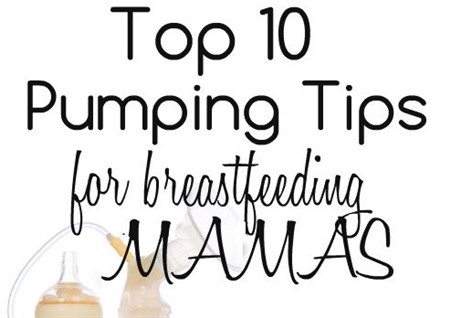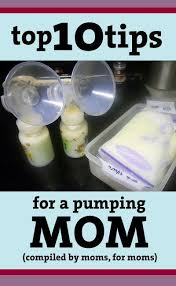
There are several reasons you may need to pump breast milk for your baby. The reasons that generally come to mind are:
- You’re going back to work.
- You want or need to have a time period of greater than three hours away from your baby.
- Your baby is having difficulty latching and you need an alternative in the mean time.
- You prefer not to breastfeed but want your baby to reap the benefits of breastmilk.
- The list could go on and on.
While everyone’s reasons for pumping may be different, there is one thing most mamas can probably agree on: Pumping is not the most fun thing in the world. However, after pretty much exclusively pumping for both of my boys (over a year and a half), I have a few tips that have made pumping easier for me.
1. Start early!
I know that when you first bring your small, cuddly, sleepy bundle of joy home from the hospital the last thing you want to even think about is pumping! Trust me, it’s worth it to start early.
There are several benefits here:
- The first benefit is that by pumping early you will increase your supply (there is a careful balance here because dealing with an oversupply can be very difficult too).
- Second, you can begin creating a “stash” of milk that you will be able to use when you go out or head back to work so you don’t have to worry as much about producing enough every day for the next day.
- Third, you are training your body how to respond to the pump and hopefully by beginning as early as possible you will eventually be able to produce better for the pump.
2. Use a double-electric or hospital-grade pump!
It is absolutely worth the money if you will be using the pump every day or if you will be using it long-term for pumping. I used my pump for both of my babies so when I consider all the money I saved not buying formula for both of them; it paid for itself time and time again. This makes such a huge difference and can save your sanity which is also worth something, right?!
3. Stay hydrated!
I can’t tell you what a difference this makes! If I am having a day with less than optimal output, I usually realize I haven’t had enough water. My hospital lactation nurse told me that if I wasn’t getting enough water, my milk was dehydrated and therefore I was dehydrating my baby; that spoke very loudly to me.
4. Pay attention to your diet!
Consider changing up your diet to see whether it makes a difference in production. – Some mamas have had success with: oatmeal, Mother’s Milk or Lactation Tea, and Lactation Cookies.
Make sure you have an adequate intake of veggies, fruits and proteins. I could absolutely see a decrease in output on days filled with pizza, high carb treats and other less than healthy options. Also, make sure you are eating enough. It’s easy to want to cut calories to lose that baby weight, but don’t cut too many!
Consider trying supplements such as Fenugreek, brewer’s yeast, Blessed Thistle, or red raspberry leaf tea (talk with a lactation specialist or doctor before trying any of these).
5. Have a specific routine you can follow!
This makes a big difference and I would venture to say it is a very personal routine. Before I headed back to work, I was really concerned about not being able to pump long-term because I knew there was no way I would be able to get away every 2-3 hours at work. I was able to get myself onto a routine in which I pumped three times per day: once in the morning, once at lunch, and once at night. This DOES NOT work for everyone! Find what works for you and your schedule and stick as closely to it as you can.
6. Get comfortable!
Make sure you wear clothing that isn’t going to make it difficult to get your flanges into the appropriate position; it is really awkward to need to undress just to pump. When I pump, I try to make sure to have a book, my computer, my cell phone, or some other means of entertainment to keep my mind off how much I am producing. It really helps me stay relaxed and, in fact, at night I use pumping time as my excuse to jump on Pinterest or whatever else I have been putting off all day.
Some people like to use a hands-free pumping bra. You can buy them online or at any store that sells maternity wear. I made my own by cutting two slits to make a small X shape into an old sports bra that had a clasp in the back.
7. Keep everything clean!
Medela has some amazing micro-steam bags that you can use in a microwave to keep your pump parts sanitized between thorough cleanings. These are amazing because you can use the same bag 20 times before it’s done and you can make sure that your parts are sterile even if you don’t have a chance to run them through the dishwasher or steam sanitizer at home. Make sure that when you do get home you take the chance to use a bottlebrush and soap to really get into all the nooks and crannies of the flanges. You shouldn’t need to clean the tubing unless milk gets in there (which can happen!).
8. Get organized!
It is important to create a system that works for you and your freezer situation. I really prefer to pump into bottles, even when I know I will be freezing the milk. I like the Lansinoh breast milk storage bagsbecause they can hold more milk than most other bags and you can lay them flat to save room in your freezer. I always make sure to label the bag and I usually wait until I have about 8 bags and then put them all into a gallon-sized Ziplock and label the entire bag with the range of dates, number of bags, and range of ounces in each bag.
9. Keep an extra set of parts (flanges, membranes, tubes) or a manual pump in your car!
One of the worst things that can happen while pumping is that you get somewhere (i.e., work) and realize that you don’t have all of your parts (or even worse your pump) and you know you will explode if you don’t pump at some point during the day. I bought an inexpensive manual pump to keep in the car as well as an extra set of flanges, membranes and tubes for the days that everything is still sitting in the dishwasher. You will forget something at some point in your pumping career— I can almost guarantee it!
10. Set realistic expectations and try to curb frustrations!
Pumping takes time, energy, and dedication. You have to keep in mind that if you are pumping at work you will need to be sure your employer or co-workers understand that this is something you are committed to doing and that you need the time to make it work. Under the federal law, you are allowed a space (not in a bathroom) and appropriate length break(s) to make this work. For additional information and state specific laws, see here. Make sure that everyone around you is on the same page. Recognize ahead of time that pumping will require sacrifices but try to keep in mind that often times that’s just what we do (just a reminder that your kiddos really do take over your ENTIRE life!). It’s OK to stop pumping if it’s just not working schedule-wise, or is more frustrating than rewarding. You are an amazing mama no matter what choices you need to make for your sanity!
Go into this knowing that some days can be hard. Some days you might be a pumping queen and other days you may barely be able to produce a couple of ounces. Don’t give up after just a couple of bad days. The best advice I can give is to take it one day at a time. You probably won’t be doing this for more than a year. Try to stay positive and think about all the money you are saving, and the wonderful nutrition you are making for your little one!
Want more tips? Check out our Ten More Tips for Pumping Mamas.
source: Top 10 Tips for a Pumping Mama


Leave a Reply